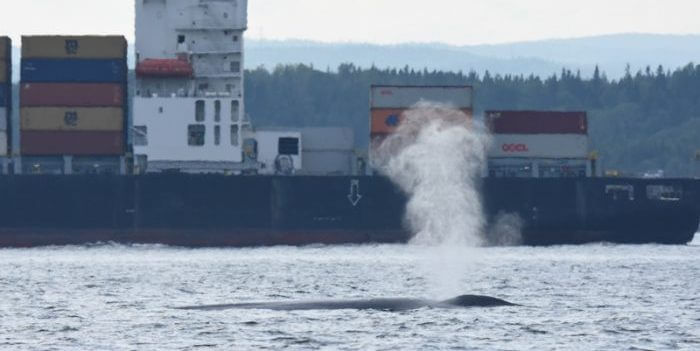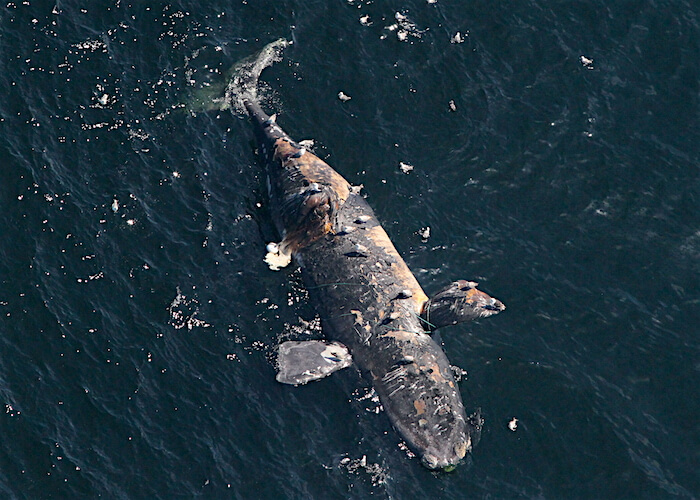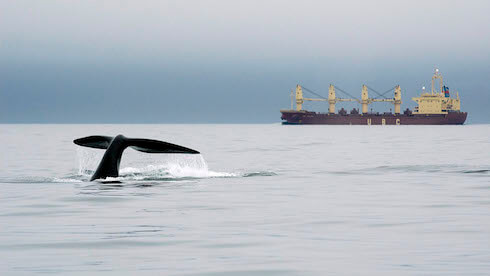In order to protect North Atlantic right whales, the Canadian government has temporarily reduced speed limits for large vessels in parts of the Gulf of St. Lawrence and its Estuary since August 11. Is reducing the speed of ships in areas heavily frequented by whales an effective and proven means to protect them? Scientific studies and the results of similar measures on the east coast of the United States seem to indicate that it is, but implementing this measure in the St. Lawrence also has its drawbacks.
Why reduce speed limits?
By putting such a measure in place, the government hopes to reduce the risk of collisions between ships and right whales. At least ten right whales have been found dead in the St. Lawrence since early June. This is more than twice the number of newborns for 2017 and almost double the average annual number of mortalities for this population (for the period 2010-2014). Given the urgency to act, the Canadian government has implemented a series of measures, including speed limit reductions.
Between 1970 and 2008, collisions with vessels were the main factor limiting the recovery of the North Atlantic right whale. In 2008, protection measures were implemented along the east coast of the US, including speed reductions and rerouted shipping corridors. Two studies conducted since 2008 have demonstrated the effectiveness of these measures in reducing the number of ship strikes.
According to a study published by NOAA researchers in 2013, restricting vessel speeds protects whales from collisions in two ways: by reducing the risk of serious or fatal injuries if a strike does occur, and by increasing the odds that a whale will have sufficient time to react and avoid the collision. Researchers estimate that in areas and periods of reduced speeds off the US east coast, the risk of a whale succumbing to a collision with a ship is reduced by 80-90%.
Another study, published in 2014, demonstrates that in the 18 years prior to implementing protective measures off the US east coast, 13 of the 15 right whale carcasses were found in or within 83 km of the future speed reduction zones, whereas during the five years after these measures were applied, no right whales were found to have been killed by collision in these areas or within 83 km thereof. Establishing seasonal speed restriction zones was therefore an effective measure to reduce this cause of mortality in and near these areas.
However, with the increase in the number of right whales visiting the Gulf of St. Lawrence during the summer season, might collisions have become once again a major cause of mortality for this population? Preliminary results of the necropsies performed on whale carcasses recovered in the St. Lawrence seem to indicate that at least three of them appear to have been victims of a collision.
Additional effects of speed restrictions on whales
Lowering ship speeds in areas that are highly patronized by whales could have another important advantage for whales: reduction of noise disturbance.
How does decreasing vessel speeds affect noise in whale habitat? “Although there is variability from one ship to another, a lower speed usually means lower instantaneous sound,” says Clément Chion, a researcher at the Université du Québec en Outaouais, although a lower speed means that the vessel is producing noise for a longer period of time, since it takes longer to reach its destination.” So how do we know whether the noise emitted by a slower-moving ship is less disturbing to the whales? Researchers on both the east and west coasts of Canada are working to answer this question.
This month, a study has begun across the country to analyze the effects of reduced vessel speeds on underwater noise and on southern resident killer whales, an endangered population with only 78 individuals. From August 7 to October 6, 2017, 53 shipping companies voluntarily participated in this study by reducing their speed to 11 knots along the Canadian west coast in the Haro Strait. Underwater hydrophones are used to measure ambient and ship noise as well as to detect the presence of whales.
Implications for the shipping industry
Although reducing speed limits for ships may have a number of positive effects for whales, this usually results in an increase in shipping times and costs. For example, the temporary reduction in speed limits in the Gulf of St. Lawrence increases the journey from St. John’s to Montréal for ships of Oceanex by seven hours, although the company compensates for some of the lost time by increasing the speed of its vessels outside regulated areas. This measure costs the company approximately $100,000 a week for its two ships travelling between St. John’s and Montréal – a loss that the company will partly pass on to its customers.







